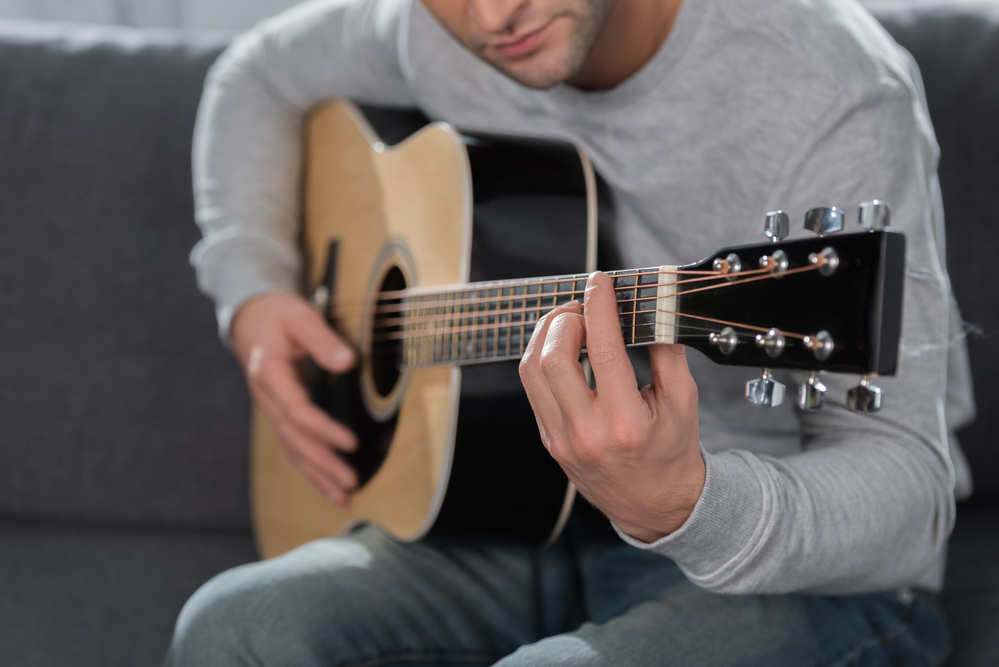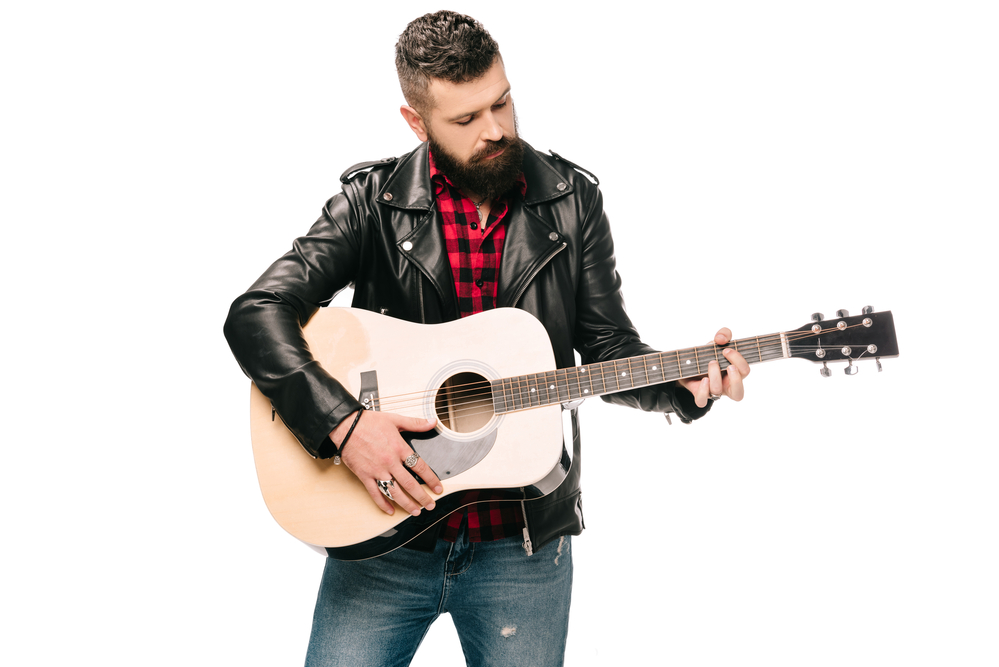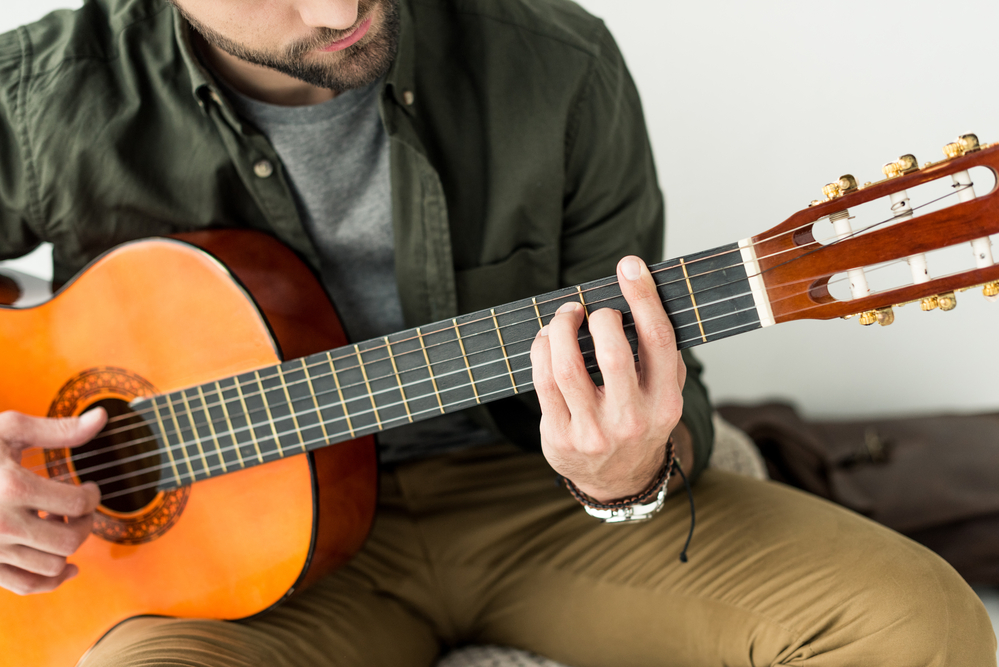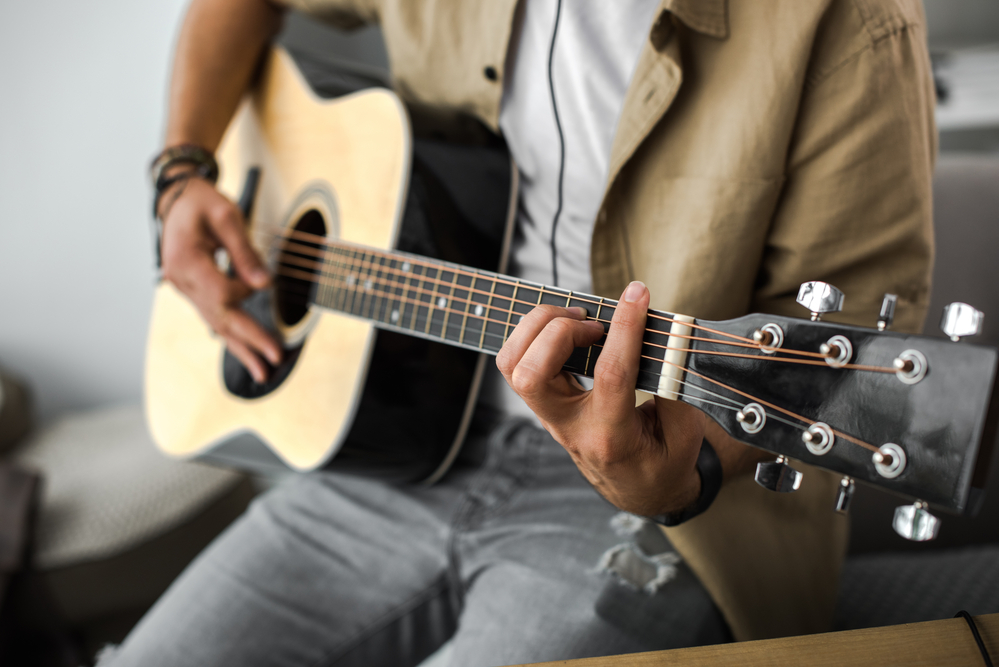Ever struggled with holding your acoustic guitar properly, feeling uncomfortable and frustrated? You’re not alone. Mastering the art of how to hold an acoustic guitar correctly is crucial for achieving optimal comfort, speed, and accuracy, ultimately enhancing your playing skills. In this comprehensive guide, we’ll walk you through the essential steps and techniques tao ensure you can hold your guitar with confidence and ease, whether you’re sitting or standing. Get ready to elevate your guitar-playing journey!
Short Summary
- Choose the right acoustic guitar based on body style, neck thickness, and size.
- Maintain proper posture when playing by selecting a comfortable chair, leg & foot placement, and balancing the instrument.
- Master techniques such as pick holding, strumming & fretting to improve sound quality and avoid common mistakes.
Choosing the Right Acoustic Guitar
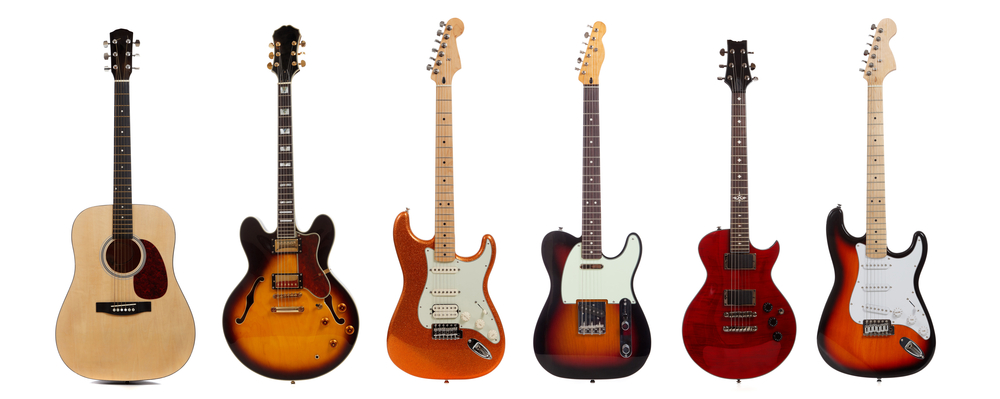
The first step in mastering the art of holding an acoustic guitar is selecting the right instrument for you. The guitar’s body style, neck thickness, and size considerations play a vital role in determining the playing comfort and ability to hold the guitar properly.
Remember, it’s crucial to adjust the guitar to your body size, rather than adjusting your body size to the guitar. So let’s explore these factors in detail to help you find the perfect acoustic guitar.
Guitar Body Styles
The body style of your acoustic guitar directly affects your ability to hold and access the guitar strings comfortably. Acoustic guitars come in various body styles, including classical, dreadnought, jumbo, parlor, and travel. Each style has its unique characteristics and impact on playing comfort, whether you’re sitting or standing.
When playing while seated, your dominant hand should be placed in front of the sound hole for optimal performance. Ultimately, it’s crucial to try different body styles and find the one that best suits your playing style, physique, and personal preferences.
Neck Thickness
The neck thickness of your acoustic guitar is another essential factor to consider. The ideal neck thickness varies depending on individual preferences and hand size, affecting your ability to play the guitar effectively. Generally, the neck thickness of an acoustic guitar ranges from 0.846 to 0.945 inches.
Use a ruler or a caliper to measure the neck thickness when choosing a classical guitar or any other type. Remember, selecting the right neck thickness will significantly impact your comfort and ease of playing, allowing you to focus on honing your guitar skills.
Size Considerations
Selecting the right guitar size is vital for maintaining proper posture and playing correctly. Factors such as arm length, hand size, and finger length should be considered when choosing the appropriate guitar size. An ill-fitting guitar can make it difficult to hold and play properly, leading to discomfort and potential injuries.
Take the time to visit a music store, try various guitars, including an electric guitar, and find the one that allows you to hold a guitar comfortably in both sitting and standing positions.
Proper Sitting Position for Acoustic Guitar Playing
Now that you’ve chosen the right acoustic guitar, it’s time to focus on the proper acoustic guitar sitting position. Sitting is often recommended for beginners as it allows for greater control over the instrument.
In this section, we will discuss tips for chair selection, leg and foot placement, and balancing the guitar, ensuring you maintain a comfortable and ergonomic position while practicing your guitar skills.
Chair Selection
The right chair plays a crucial role in maintaining good posture while playing the guitar. Choose a chair without arms that allows both feet to remain on the floor and keeps your knees at a right angle. Some popular options include wooden chairs handcrafted for the purpose, guitar stools like the Stagg GIST-300 or the Roc-N-Soc tower saddle, and chairs with backrests like the Quik Lok guitar chair.
Remember, maintaining a straight back and relaxed shoulders is essential when playing the guitar, so avoid slouching or hunching over.
Leg and Foot Placement
Proper leg and foot placement is essential for playing the guitar correctly while in a sitting position. Position your guitar on your right leg, raising it if possible. Keep your feet slightly separated and your back upright. Avoid common errors such as slouching, keeping your feet too close together, and not positioning your guitar close enough to your body.
Practicing proper left leg and foot placement will help you maintain optimal posture and prevent potential injuries.
Balancing the Guitar
Balancing your acoustic guitar on your lap while maintaining a comfortable and ergonomic position is crucial for effective playing. Rest the bottom curve of the guitar on your inner right thigh and support it with your dominant arm’s elbow and forearm. Use your left arm to position the guitar neck between your thumb and forefinger.
Remember, finding the right balance will not only improve your playing comfort but also prevent unnecessary strain on your body.
Holding the Acoustic Guitar While Standing
After mastering the sitting position, it’s time to learn how to hold your acoustic guitar while standing. In this section, we’ll discuss tips for strap selection, adjustment, and maintaining proper posture while standing. Ensuring you can transition smoothly between sitting and standing positions while playing your guitar is key.
When selecting a strap, make sure it’s comfortable and adjustable. It should be wide enough to distribute the weight of the guitar evenly across your shoulder. The length should be adjustable.
Strap Selection
Choosing a comfortable and supportive guitar strap is vital when playing your acoustic guitar while standing. Leather, nylon, and polyester straps are popular options, as well as single-button straps for acoustic guitars, two-button straps for both acoustic and electric guitars, and specialized hook straps for guitars without knobs.
Prioritize comfort when selecting a strap, as padded straps and wider straps generally provide more comfort than non-padded and narrower straps.
Strap Adjustment
Adjusting your guitar strap correctly is essential for maintaining a consistent playing position between sitting and standing. To adjust the strap, ensure that your guitar is slightly elevated above your thigh while sitting and hangs at a comfortable height while standing.
Finding the right strap length will not only improve your comfort but also help you maintain good posture regardless of your playing position.
Posture Tips
Maintaining proper posture while playing your acoustic guitar standing up is crucial for preventing injuries and ensuring comfort. Keep your back straight, and shoulders relaxed, and avoid slouching or hunching over the guitar. Position your guitar so that the neck is inclined upward at a 30-degree angle, allowing for smooth pivoting over the strings.
Practicing proper posture while standing will help you transition seamlessly between sitting and standing positions, enhancing your guitar-playing skills.
Hand Positioning on the Acoustic Guitar
With your guitar held comfortably, it’s time to focus on proper hand positioning on the acoustic guitar. In this section, we’ll discuss techniques for optimal fretting and strumming hand positions, as well as thumb placement. Ensuring you can play your guitar with ease and precision is key to becoming a great guitarist. With the right-hand positioning, you can play with accuracy and speed, allowing you to create beautiful music. By following the tips in this section, you will be able to follow the tips in this section.
Fretting Hand Position
The fretting hand position is vital for comfortable and efficient guitar playing. Grip the neck of your acoustic guitar around its center, keeping your fingers close to the frets and your wrist relatively straight. Curve your fingers and avoid applying excessive pressure when fretting.
Remember, practicing proper fretting hand position will improve your playing comfort and help you achieve a clean, consistent sound.
Strumming Hand Position
For a clean and consistent sound, it’s essential to maintain proper strumming hand position. Position your hand flat against the guitar body just behind the bridge, holding the pick at a 90-degree angle to the body of the guitar. Align your strumming arm parallel to the face of the guitar, ensuring a smooth and even strumming motion.
Practice different strumming patterns and techniques to find the ones that suit your playing style best.
Thumb Placement
The thumb placement on the guitar neck plays a significant role in comfortable and efficient playing. The ideal thumb placement is typically located between the middle and top of the neck, ensuring stability and reducing strain on your thumb.
Practicing proper thumb placement will enhance your playing comfort and allow you to focus on mastering your guitar skills.
Mastering Basic Techniques
Now that you’ve learned the proper hand positioning and thumb placement, it’s time to master the basic techniques of holding a guitar pick, strumming, and fretting.
In this section, we’ll provide you with tips and techniques to help you improve your guitar-playing skills and achieve a clean, consistent sound.
Holding a Guitar Pick
Holding a guitar pick comfortably and effectively is essential for clean and consistent sound production. Grip the pick between your thumb and index finger, applying enough pressure to strike the strings without becoming rigid. Hold the pick at a 90-degree angle to the body of the guitar and closer to the tip for better control.
Practicing proper pick-holding technique will improve your playing precision and help you achieve a cleaner sound.
Strumming Techniques
To achieve a clean and consistent sound, practice various strumming techniques, such as downward and upward strumming or combining them in a simple pattern. Ensure you maintain a loose wrist, use a light grip on the pick, and avoid hitting all the strings with each strum.
Practicing different strumming techniques will help you find the ones that suit your playing style best and improve your sense of rhythm and timing.
Fretting Basics
The basics of fretting involve pressing down on the strings with your fingers to produce various notes. Keep your fingers close to the frets and press down firmly but not too forcefully.
Practice using different fingers to fret distinct notes and experiment with various chord shapes and fingerings. Mastering the basics of fretting will improve your playing technique and help you achieve a clean, consistent sound when you play guitar.
Common Mistakes and How to Avoid Them
As a beginner, it’s common to make mistakes when holding an acoustic guitar. In this section, we’ll discuss some of the most frequent errors and provide tips on how to avoid them.
By being aware of these mistakes and following our guidelines, you’ll be able to hold your guitar properly and improve your playing skills.
Practicing with Purpose
To improve your guitar playing skills and techniques, it’s essential to practice with purpose. Utilize a metronome to develop your sense of rhythm and enhance your timing. Set the metronome to a slow tempo and gradually increase the speed as you become comfortable with the beat.
In addition, focus on maintaining proper posture and hand positioning while practicing. Remember, consistent and purposeful practice is the key to mastering the art of holding and playing your acoustic guitar.
Transitioning Between Sitting and Standing Positions
Being able to seamlessly transition between sitting and standing positions while playing your acoustic guitar is crucial for versatility and comfort. In this section, we’ll provide guidelines for adjusting your guitar strap and maintaining a consistent playing position when transitioning between sitting and standing.
By following these tips, you’ll be able to play your guitar comfortably in any position.
Summary
Mastering the art of holding an acoustic guitar is a crucial skill for any aspiring guitarist. By choosing the right guitar, maintaining proper posture, and practicing with purpose, you can enhance your playing skills and enjoy a comfortable and rewarding guitar playing experience. Remember, consistent practice and attention to detail are key to your success. So pick up your guitar, follow our guidelines, and get ready to take your guitar-playing journey to new heights!
Frequently Asked Questions
What is the most comfortable way to hold a guitar?
For a comfortable and efficient grip on your guitar, position it so that the neck is resting on your non-dominant side and your arm is slightly curved, holding the body of the guitar firmly but gently. To stabilize the neck, form a “V” shape with your thumb and first finger and press down lightly on the frets. This will keep your guitar in place while you play.
How to hold a guitar?
To properly hold a guitar, keep your back straight, tuck the guitar under your elbow, and rest the body of the guitar in a slightly horizontal position. Adjust as needed for comfortable playing while keeping your feet flat on the floor.
For fingerstyle playing, make sure to curl your thumb over the fretboard. With this positioning, you’ll be able to play comfortably with ease.
How to hold a guitar pick?
To hold a guitar pick correctly, form a loose fist with your picking hand and lay the pick on the side of the first knuckle of your index finger. Curl your thumb across your index finger with the pick to form a “T” shape.
Lastly, curl your index finger towards your fist to keep it out of the way. This will ensure that your grip is firm but relaxed.
What is the importance of selecting the right acoustic guitar for optimal comfort and playability?
Choosing the right acoustic guitar is essential for optimum comfort and playability so that you can make the most out of your musical experience. Picking the correct guitar will improve your enjoyment and help you reach your full potential as a musician.
How can I ensure proper leg and foot placement while playing my acoustic guitar sitting down?
To ensure proper leg and foot placement when playing an acoustic guitar sitting down, keep your back straight, raise the guitar to a comfortable height on your right leg, and ensure that your feet are slightly separated.
This will help you maintain good posture and ensure that your hands are in the correct position to play the guitar. It will also help you avoid any strain or discomfort while playing.


